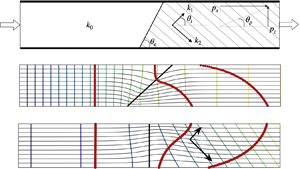Article contents
Shear generation in a confined, composite layer of cross-bedded porous rock
Published online by Cambridge University Press: 29 July 2020
Abstract

We study the longitudinal spreading of a passive tracer by a two-dimensional pressure-driven flow through a composite layer of porous rock which is bounded above and below by impermeable seal rock. We focus on the flow across the interface between two neighbouring zones of the rock. First, we show that, with isotropic permeability, if the interface between the two zones is tilted relative to the boundaries, then this results in a difference in travel times across the formation which in turns leads to a net shear flow. We explore the strength of this shear as a function of (a) the permeability ratio across the interface, and (b) the interface angle. Second, we show that if one zone of the rock is cross-bedded, then with uniform flow, the pressure gradient is directed at an angle to the boundary. As a result, there is a transition zone across the interface, which again leads to a net shear, even if the interface is normal to the boundaries of the layer. We explore the competition between these effects, showing how they may combine constructively to produce a larger shear, or may negate one another, reducing or reversing the sign of the shear, depending on the angle of the interface, the degree of anisotropy and the change in effective downstream permeability across the interface. We discuss some of the implications of this shear for modelling flow in such composite rocks.
JFM classification
Information
- Type
- JFM Rapids
- Information
- Copyright
- © The Author(s), 2020. Published by Cambridge University Press
References
REFERENCES
- 3
- Cited by

